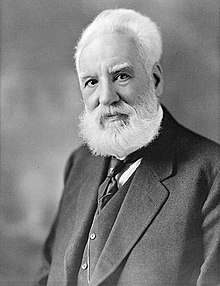|
GUIDELINES
Download BEST OF 3 JOURNAL MONTH
RECOMENDED TOOLS
|
Reviewer Team

Alexander Graham Bell (/ˈɡreɪ.əm/, born Alexander Bell; March 3, 1847 – August 2, 1922)[4] was a Scottish-born[N 1] inventor, scientist and engineer who is credited with patenting the first practical telephone. He also co-founded the American Telephone and Telegraph Company (AT&T) in 1885.[7]
Bell's father, grandfather, and brother had all been associated with work on elocution and speech, and both his mother and wife were deaf; profoundly influencing Bell's life's work.[8] His research on hearing and speech further led him to experiment with hearing devices which eventually culminated in Bell being awarded the first U.S. patent for the telephone, on March 7, 1876.[N 2] Bell considered his invention an intrusion on his real work as a scientist and refused to have a telephone in his study.[9][N 3]
Many other inventions marked Bell's later life, including groundbreaking work in optical telecommunications, hydrofoils, and aeronautics. Bell also had a strong influence on the National Geographic Society[11] and its magazine while serving as the second president from January 7, 1898, until 1903.
Beyond his work in engineering, Bell had a deep interest in the emerging science of heredity.[12] His work in this area has been called "the soundest, and most useful study of human heredity proposed in nineteenth-century America...Bell's most notable contribution to basic science, as distinct from invention."[13]
|
Leonardo da Vinci
|
|
|---|---|

This portrait attributed to Francesco Melzi, c. 1515–1518, is the only certain contemporary depiction of Leonardo.[1][2]
|
|
| Born |
Leonardo di ser Piero da Vinci
15 April 1452 |
| Died | 2 May 1519 (aged 67) Clos Lucé, Amboise, Kingdom of France
|
| Education | Studio of Andrea del Verrocchio |
| Years active | c. 1470–1519 |
| Known for |
|
| Notable work |
|
| Movement | High Renaissance |
| Family | Da Vinci family |
| Signature | |
 |
|
Leonardo di ser Piero da Vinci[b] (15 April 1452 – 2 May 1519) was an Italian polymath of the High Renaissance who was active as a painter, draughtsman, engineer, scientist, theorist, sculptor, and architect.[3] While his fame initially rested on his achievements as a painter, he also became known for his notebooks, in which he made drawings and notes on a variety of subjects, including anatomy, astronomy, botany, cartography, painting, and paleontology. Leonardo is widely regarded to have been a genius who epitomized the Renaissance humanist ideal,[4] and his collective works comprise a contribution to later generations of artists matched only by that of his younger contemporary Michelangelo.[3][4]
Born out of wedlock to a successful notary and a lower-class woman in, or near, Vinci, he was educated in Florence by the Italian painter and sculptor Andrea del Verrocchio. He began his career in the city, but then spent much time in the service of Ludovico Sforza in Milan. Later, he worked in Florence and Milan again, as well as briefly in Rome, all while attracting a large following of imitators and students. Upon the invitation of Francis I, he spent his last three years in France, where he died in 1519. Since his death, there has not been a time where his achievements, diverse interests, personal life, and empirical thinking have failed to incite interest and admiration,[3][4] making him a frequent namesake and subject in culture.
Leonardo is identified as one of the greatest painters in the history of art and is often credited as the founder of the High Renaissance.[3] Despite having many lost works and fewer than 25 attributed major works—including numerous unfinished works—he created some of the most influential paintings in Western art.[3] His magnum opus, the Mona Lisa, is his best known work and often regarded as the world's most famous painting. The Last Supper is the most reproduced religious painting of all time and his Vitruvian Man drawing is also regarded as a cultural icon. In 2017, Salvator Mundi, attributed in whole or part to Leonardo,[5] was sold at auction for US$450.3 million, setting a new record for the most expensive painting ever sold at public auction.
Revered for his technological ingenuity, he conceptualized flying machines, a type of armored fighting vehicle, concentrated solar power, a ratio machine that could be used in an adding machine,[6][7] and the double hull. Relatively few of his designs were constructed or were even feasible during his lifetime, as the modern scientific approaches to metallurgy and engineering were only in their infancy during the Renaissance. Some of his smaller inventions, however, entered the world of manufacturing unheralded, such as an automated bobbin winder and a machine for testing the tensile strength of wire. He made substantial discoveries in anatomy, civil engineering, hydrodynamics, geology, optics, and tribology, but he did not publish his findings and they had little to no direct influence on subsequent science.[8]

